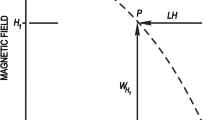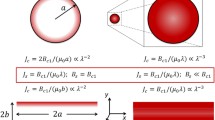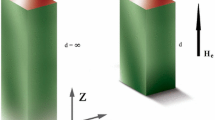Abstract
THE superconducting state of a material can be suppressed by either increasing the temperature (T) or applying a magnetic field (H). For bulk samples, the form of the H–T phase boundary is mainly determined by the material itself; sample topology can be neglected because the surface-to-volume ratio is small1. But for mesoscopic samples, this ratio becomes very large and nucleation of the superconducting state should depend strongly on the boundary conditions imposed by the sample shape, analogous to the role of the confining potential on the energy levels in the quantum-mechanical 'particle-in-a-box' problem2. Here we describe measurements of the superconducting H-T phase boundary of a range of mesoscopic aluminium structures (lines, squares and square rings) which show clearly the effect of sample topology. The H-T phase boundaries determined experimentally are in excellent agreement with theoretical calculations.
Similar content being viewed by others
References
de Gennes, P. G. Superconductivity in Metals and Alloys (Addison-Wesley, New York, 1989).
Merzbacher, E. Quantum Mechanics (Wiley, New York, 1961).
Abrikosov, A. A. Fundamentals of the Theory of Metals (North-Holland, Amsterdam, 1988).
Saint-James, D. Phys. Lett. 15, 13–15 (1965).
Pannetier, B. in Quantum Coherence in Mesoscopic Systems (ed. Kramer, B.) 457–484 (Plenum, New York, 1991).
Little, W. A. & Parks, R. D. Phys. Rev. Lett. 9, 9–13 (1962).
Tinkham, M. Introduction to Superconductivity (McGraw-Hill, New York, 1975).
Dingle, R. B. Proc. Roy. Soc. A212, 47–65 (1952).
Welker, H., Bayer S. B. Akad. Wiss. 14, 115–118 (1938).
Groff, R. P. & Parks, R. D. Phys. Rev. 176, 567–578 (1968).
Tinkham, M. Phys. Rev. 129, 2413–2422 (1963).
Santhanam, P., Chi, C. C., Wind, S. J., Brady, M. J. & Bucchignano, J. J. Phys. Rev. Lett. 66, 2254–2258 (1991).
Vloeberghs, H., Moshchalkov, V. V., Van Haesendonck, C., Jonckheere, R. & Bruynseraede, Y. Phys. Rev. Lett. 69, 1268–1272 (1992).
Moshchalkov, V. V., Gielen, L., Neuttiens, G., Van Haesendonck, C. & Bruynseraede, Y. Phys. Rev. B49, 15412–15416 (1994).
Author information
Authors and Affiliations
Rights and permissions
About this article
Cite this article
Moshchalkov, V., Gielen, L., Strunk, C. et al. Effect of sample topology on the critical fields of mesoscopic superconductors. Nature 373, 319–322 (1995). https://doi.org/10.1038/373319a0
Received:
Accepted:
Issue Date:
DOI: https://doi.org/10.1038/373319a0
- Springer Nature Limited
This article is cited by
-
Non-conventional superconductivity in magnetic In and Sn nanoparticles
Scientific Reports (2022)
-
Topological transitions in ac/dc-driven superconductor nanotubes
Scientific Reports (2022)
-
Vortex Matter in a Two-Band SQUID-Shaped Superconducting film
Journal of Low Temperature Physics (2022)
-
Thermo-Magnetic Signature of a Superconducting Multi-band Square with Rough Surface
Journal of Low Temperature Physics (2021)
-
Spontaneous emergence of Josephson junctions in homogeneous rings of single-crystal Sr2RuO4
npj Quantum Materials (2020)





